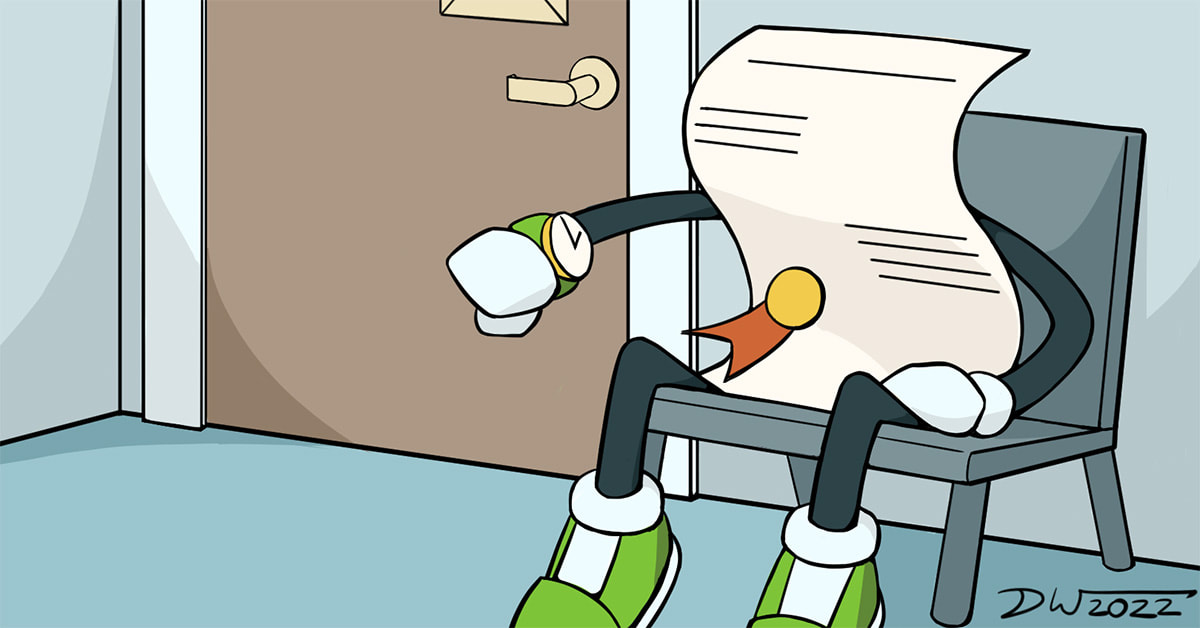|
By: Kristen Hansen
Illustration: Declan Wrede
When does a U.S. patent expire?
In general, a utility patent expires 20 years from the filing date of the patent application. This 20-year patent term begins at the filing date of the first U.S. non-provisional patent application, which would include the filing date of an international PCT application if that was the first non-provisional filing.
How long do provisional patents last?
Provisional patents, which function as a placeholder for a utility patent application, expire 12 months from the filing date of the provisional patent application. These applications are not examined; they truly sit as a placeholder awaiting to be converted to a non-provisional patent application, but function to the applicant’s advantage in securing the earliest possible filing date in the U.S.-based first-to-file system.
Possible exception. When a non-provisional application is filed more than 12 months after the filing date of the provisional application, but within 14 months after the filing date of the provisional application, an applicant may restore the benefit of the provisional application by filing a petition that includes a fee and a statement that the delay in filing the non-provisional application was unintentional. Impact on 20-year term. Domestic priority benefit to one or more U.S. provisional applications is not considered in the calculation of the 20-year term of a patent. In other words, the one-year window given by the provisional is not deducted from the possible 20-year term (21 years from the filing date of the provisional application, as opposed to 19). How long do utility patents last?
Utility patents, which protect the way an article is used and works (e.g., systems, methods, computer-readable mediums, etc.), typically expire 20 years from the date of patent application filing. However, If the application claims priority to any earlier filed applications (e.g., a related provisional application(s) or related U.S. non-provisional application(s)), the application will expire 20 years from the filing date of the earliest of such applications.
How long do plant patents last?
Plant patents, which protect newly discovered asexually reproduced plants, expire 20 years from the date of filing of the patent application. However, If the application claims priority to any earlier filed U.S. provisional or U.S. non-provisional applications, the application will expire 20 years from the filing date of the earliest of such applications.
How long do design patents last?
Design patents, which protect the way an article looks (i.e., ornamental appearance), filed before May 13, 2015 expire 14 years from the date of the patent grant. Design patents filed on or after May 13, 2015 have an expiration of 15 years from the date of the patent grant. Note that design patents are aged from a patent grant date, while plant and utility patents age from a patent application filing date.
How long do continuing patent applications last?
Continuing patent applications, which include continuations, divisional, or continuation-in-part applications (e.g., child applications) that claim priority to an earlier patent (e.g., parent, grandparent application) expire 20 years from the filing date of the earliest U.S. patent application in which benefit is claimed.
How long do international patents last?
International patent applications that are granted as national stage entry filings of the international application expire 20 years from the filing date of the international application. A continuation or continuation-in-part application claiming benefit to the international application and designating the U.S. expires 20 years from the filing date of the parent international application.
Foreign priority is not considered in determining patent term/expiration. A U.S. non-provisional application that claims priority to a foreign patent application or patent expires 20 years from the U.S. non-provisional application filing date. Can you extend a patent?
You may only extend the concept of a patent by inventing and patenting an improvement to the originally patented invention (which is a new invention).
Patent Term Extensions (PTE) or Patent Term Adjustments (PTA), however, can extend portions of the patent term (by days, months, or years) based on adjusting for delays by the Patent Office and delays by the Applicant during prosecution. This amount of PTE/PTA is typically listed on the face of the patent. Terminal disclaimers can further disclaim part of a patent term and typically come into play in continuation or continuation-in-part filings. A terminal disclaimer is a type of time limit on a patent. A terminal disclaimer typically comes into play when an inventor’s first patent application and a later filed patent application include claimed content that is too similar to one another. If the patent office awards a patent to the later filed patent application, then the patent office may require that the inventor file a terminal disclaimer that effectively forces the later filed patent to expire when the first patent expires.
What happens after a patent expires?
The patented invention becomes freely usable by others and is considered public domain. At this time, others may freely make and use the invention without paying royalties to the inventor(s). Note that improvements to an invention in the public domain can be covered by separate patents that may have been obtained later than the original patent. The improvements patent(s) may still remain in effect and can block others from making or using the improved invention.
Why do patents last for so long?
Many innovations require billions of dollars in R&D. The road to every success is paved with countless iterations of failures. The 20-year term gives innovators an opportunity to recapture losses and profit from their discoveries without the threat of competitors pirating and profiting from innovations they didn’t invest in to create. Since the inventions are published, competitors still have the ability to learn from the advancements, design around them, or even build upon them with improvements. The fundamental ability to license a patent, as a transferable property right, provides a bridge from intellectual to real capital and prevents this 20-year term from being a blockade to innovation.
Why do patents expire?
Patents expire to prevent the possibility of unlimited monopolies. Large entities could swallow up entire industries and prevent progress in particular technologies. The 20-year term satisfies the quid pro quo grand bargain of an exclusive, but limited, property right to inventors in exchange for an enabling (and lasting!) public disclosure.
When do drug patents expire?
Drug patents are utility patents and thus expire 20 years from the date of patent application filing. Drug patents do, however, provide some unique opportunities to extend exclusivity, not found in other patent domains. We’ve outlined some highlights below, but for a more detailed discussion of options, please see: Drug Patents and the FDA: Timelines, Exclusivity, and Extensions.
The PTE/PTA calculation may apply here to extend the application if delays occurred during prosecution of the patent.
When do medical patents expire?
Medical patents (e.g., systems, methods, computer software for medical methods, methods of treatment, etc.) are utility patents and thus expire 20 years from the filing date of the patent application.
Is there a patent term expiration calculator?
Yes. The USPTO provides a downloadable patent term expiration calculator.
Need help determining your patent term?
This can all get a little convoluted with concepts like continuations, terminal disclaimers, regulatory-based extensions, etc. If you could use some help sorting through this and maximizing your patent’s lifespan, please reach out!
Related Resources
0 Comments
Leave a Reply. |
Ashley Sloat, Ph.D.Startups have a unique set of patent strategy needs - so let this blog be a resource to you as you embark on your patent strategy journey. Archives
July 2024
Categories |



 RSS Feed
RSS Feed